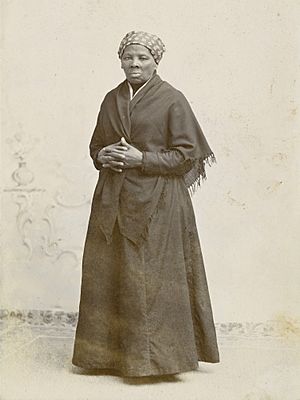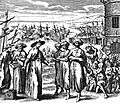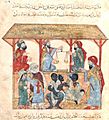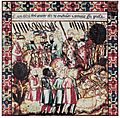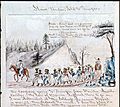Slavery facts for kids
Slavery is when one person is treated like they belong to another person. This person is called a slave, and the owner is called a slavemaster. Slavemasters treated slaves like things they owned. They forced them to work without pay. Slaves could not leave, make their own choices, or even stay with their families. It was a very unfair and wrong system.
Slavery has changed over time. It looked different in various parts of history. Sometimes people were captured in wars and made to work. Other times, people were born into slavery. This meant they were enslaved from birth. Their children were also enslaved, trapping families for many generations.
During the 1900s, almost all countries made laws against slavery. The Universal Declaration of Human Rights says that slavery is wrong. Slavery is now banned by international law. However, some forms of forced labor still exist in certain places today.
Contents
Where the Word "Slave" Comes From
The English word "slave" comes from a word used in the Middle Ages. It came from the word for the Slavic peoples of Central Europe and Eastern Europe. These people were one of the last groups to be captured and enslaved in Central Europe.
Slavery in Ancient Times
Slavery was common in old civilizations like Egypt, Greece, and Rome. In ancient Egypt, some people became slaves because they owed money or as punishment. In ancient Greece and Rome, slaves did many jobs. They worked in farming, mining, homes, and even as teachers. Many were prisoners taken during wars. The number of enslaved people was a big part of these societies.
Slavery in Different Parts of Africa
Before the transatlantic slave trade, slavery existed in Africa for hundreds of years. It was often different from what happened later. Slaves in Africa sometimes had more rights. They could even gain their freedom or become important leaders. But this did not make the system fair or right. Slavery varied a lot across the many cultures in Africa. People were enslaved through war, debt, or as punishment for crimes.
The Terrible Transatlantic Slave Trade
This was a very sad time in human history. Millions of people from Africa were taken from their homes by force. They were shipped across the Atlantic Ocean in terrible conditions. Then they were sold into slavery in the Americas. This included North America, Central America, South America, and the Caribbean. This journey was called the "Middle Passage."
The Middle Passage: A Horrible Journey
The ships were very crowded. Many people died from sickness, starvation, or violence during the trip. The transatlantic slave trade started in the 1400s. It lasted for over 300 years, ending in the 1800s. The exact dates varied by country.
How Many People Were Enslaved?
Experts believe 10 to 12 million people were enslaved during this trade. This is a huge number. Many more people died during their capture and transport.
Impact on Africa and the Americas
The slave trade badly hurt Africa. It broke apart societies and caused wars. Many families were separated forever. The loss of so many strong, young people affected Africa's growth for generations.
In the Americas, enslaved people were forced to work on large farms called plantations. They grew crops like sugar, tobacco, cotton, and rice. They faced harsh treatment, long hours, and separation from their loved ones. Slavery deeply shaped the societies and economies of the Americas.
Slavery in the United States
In the United States, slavery was legal in many states. It ended in 1865. This happened when the 13th Amendment was added to the Constitution. Before that, millions of people were enslaved. Most of them were of African descent.
The Civil War and Ending Slavery
The Civil War (1861-1865) was a major war in the United States. It was largely fought because of slavery. Southern states, which used a lot of enslaved labor, left the Union. This led to the war. The Union won, and slavery ended in the United States.
Brave People Who Fought Slavery
Many brave people fought against slavery. They were called Abolitionists. They risked their lives to speak out against slavery's wrongs. They helped enslaved people escape. They also worked to end slavery completely. Famous abolitionists include Frederick Douglass and Harriet Tubman.
Slavery After It Was Banned
Even after slavery was legally ended in many places, other forms of forced labor continued. This included things like indentured servitude. In this system, people had to work for a certain time to pay off a debt. Sadly, forced labor and human trafficking still exist in some parts of the world today.
Famous People Who Were Slaves
- Aesop (around 6th century BC)
- Spartacus (died 71 BC)
- Epictetus (about AD 55 - AD 125)
- Pope Callixtus I (died AD 222)
- Saint Patrick (around AD 387-461)
- Olaudah Equiano (around 1745-1790)
- George John Scipio Africanus (1763-1834)
- Denmark Vesey (around 1767-1822)
- Sojourner Truth (around 1797-1883)
- Dred Scott (around 1799-1845)
- Nat Turner (1800-1831)
- Frederick Douglass (around 1812-1895)
- Harriet Tubman (1820-1913)
- Booker T. Washington (1856-1915)
- Solomon Northup
Related Pages
Images for kids
-
Relief showing slaves in chains in the Roman Empire, around 200 CE
-
A poster for a slave auction in Georgia, U.S., 1860
-
Picture of an older woman in New Orleans with her enslaved servant girl in the mid-1800s
-
The Mercedarians helped free Christian slaves in North Africa (1637).
-
Barefooted slaves in David Roberts' Egypt and Nubia, 1845-1849
-
Ishmaelites buy Joseph, by Schnorr von Carolsfeld, 1860
-
13th-century slave market in Yemen.
-
Adalbert of Prague asks Boleslaus II, Duke of Bohemia to free slaves
-
A British captain sees the suffering of slaves in Ottoman Algeria, 1815
-
Slavic and African slaves in Córdoba, from Cantigas de Santa Maria, 13th Century
-
Crimean Tatar raiders enslaved over 1 million Eastern Europeans.
-
19th-century picture of an Arab slave-trading caravan moving black African slaves across the Sahara Desert.
-
Slave market in Algiers, 1684
-
Arab-Swahili slave traders and their captives on the Ruvuma River in East Africa, 19th century
-
A model showing a typical 1700s European slave ship on the Middle Passage, National Museum of American History.
-
Slaves in Cuba unloading ice from Maine, 1832
-
Saint-Domingue slave revolt in 1791
-
Planting sugar cane, British West Indies, 1823
-
A group of slaves being forced to walk from Staunton, Virginia to Tennessee in 1850.
-
A contract from the Tang dynasty for buying a 15-year-old slave.
-
Persian slave in the Khanate of Khiva, 19th century
-
Tuareg society traditionally had nobles, vassals, and dark-skinned slaves.
-
Olaudah Equiano, his book helped end the African slave trade for Britain.
-
Joseph Jenkins Roberts, born in Virginia, was the first president of Liberia.
See also
 In Spanish: Esclavitud para niños
In Spanish: Esclavitud para niños


